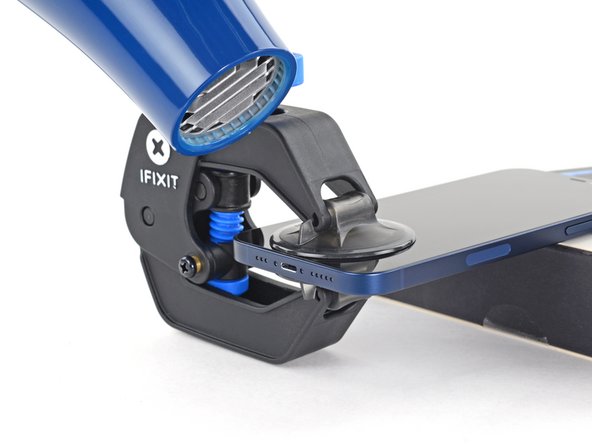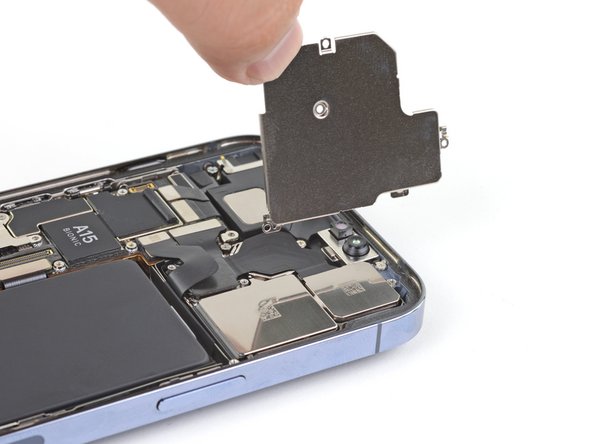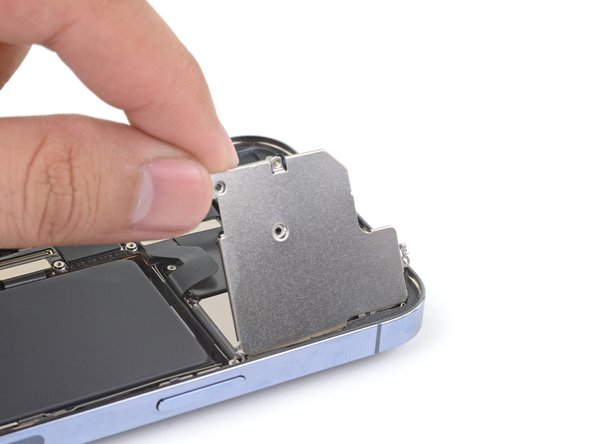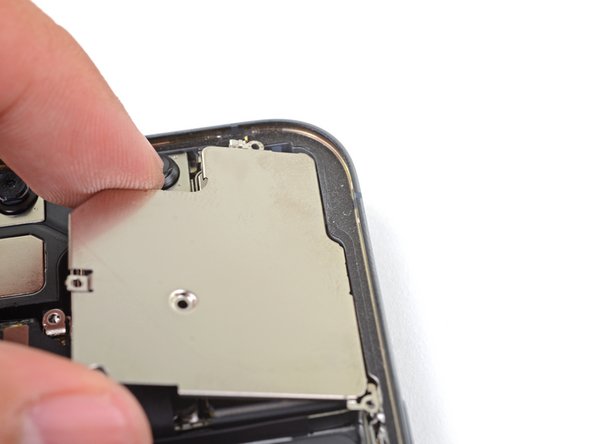iPhone 13 Pro Max Lidar Sensor Replacement
Duration: 45 minutes
Steps: 35 Steps
Ready to swap out the LiDAR sensor on your iPhone 13 Pro Max? Follow this straightforward guide to get it done step by step with confidence.
Step 1
Heads up: Before you dive in, make sure your iPhone battery is under 25%. Accidentally poking a fully charged lithium-ion battery can turn your repair session into a fireworks show—minus the fun. Keep it cool and powered down!
Opening up your iPhone's display means those waterproof seals are going to take a hit. Make sure you've got some replacement seals on standby before diving into this step, or just be extra careful to dodge any liquid if you're putting your iPhone back together without swapping out those seals.
- First things first, let's power down your iPhone before we dive into the fun of disassembly!
- Next up, grab your trusty pentalobe P2 screwdriver and remove those two 6.8 mm-long screws at the bottom edge of your iPhone. You got this!
Step 2
Be careful not to push the opening pick in too deep, or you might accidentally harm your device. To avoid any mishaps, let's mark the pick to keep everything safe.
Feel free to mark the other corners of the pick with various measurements for added precision.
Another handy trick is to tape a coin to the pick about 3 mm from the tip. This can help guide your way!
- Take your trusty ruler and measure 3 mm from the end of the opening pick. Give it a little mark with a permanent marker so you know where to get cutting!
Step 3
Pop on some safety glasses—your eyes deserve VIP treatment if glass decides to break loose during the fix.
Got a cracked screen on your iPhone? No worries! Grab some tape and cover that glass to keep it from getting worse and to protect yourself while you work your magic.
And if you're really in a bind, a little superglue on the suction cup can do the trick to stick it to the screen. Just remember, it's a temporary fix!
- Cover the iPhone's screen with overlapping strips of clear packing tape until the entire face is nicely sealed. It's like giving your phone a protective hug!
- If the suction cup gives you trouble in the next few steps, don't worry! Just take a sturdy piece of tape (like duct tape), fold it into a handle, and use that to lift the screen instead. You've got this!
Tools Used
Step 4
The next three steps will show off the Anti-Clamp—a nifty tool designed to make opening your device a breeze. Not using the Anti-Clamp? Just skip ahead three steps for another way to tackle the job.
Want the full scoop on using the Anti-Clamp? Check out this guide.
If your iPhone is slicker than a greased watermelon and the Anti-Clamp is slipping, try using some tape to give it a bit more grip.
- Give that blue handle a gentle pull backwards—this unlocks the Anti-Clamp’s arms and gets the party started.
- Slide those arms over either the left or right edge of your iPhone. No need to play favorites; both sides work.
- Set the suction cups close to the bottom edge—one chilling on the front, one hanging out on the back.
- Press the cups together to create some solid suction right where you need it.
Step 5
- Slide the blue handle away from the hinge—this kicks off opening mode.
- Give the handle a clockwise spin and watch those cups stretch out like they're warming up for a big day.
- Keep the suction cups lined up with each other. If they're starting to drift apart, just loosen them a bit and get those arms back in sync.
Step 6
Take it easy! Just give it a gentle twist of no more than a quarter turn at a time, and then chill for a minute between each twist. Let the Anti-Clamp and the clock do their magic for you.
For a detailed rundown on using a hair dryer like a pro, check out this guide.
If the Anti-Clamp isn't opening up enough space, just add a little more heat to the area and give the handle a quarter twist.
- Place your iPhone on a solid surface, like a trusty hardcover book, so it can chill hands-free and sit parallel to the ground. This little setup will make your repair journey much smoother!
- Grab a hair dryer and give the bottom edge of your iPhone a warm hug. It should feel just a tad too hot to touch – that's the sweet spot!
- Take a breather and wait for a minute. This allows the adhesive to loosen up, giving you a nice opening gap to work with.
- Once the Anti-Clamp creates a gap big enough, slide an opening pick under the screen's plastic bezel. Time to make some magic happen!
- Feel free to skip the next three steps. You’ve got this!
Tools Used
Step 7
Keep your hair dryer on the move – don’t let it linger in one spot too long!
- Grab your hair dryer or heat gun and warm up the bottom edge of your iPhone for about 90 seconds, or until it’s just a little too warm to touch comfortably.
Tools Used
Step 8
The watertight adhesive securing the screen is quite the tough cookie; getting that first gap open requires a bit of elbow grease. If you're struggling to make a gap, try adding a little more heat and gently wiggling the screen up and down to loosen the adhesive. Once you've got enough of a gap, you can slip your tool in there like a pro.
- Grab a suction handle and stick it right to the bottom edge of your phone, but steer clear of the very edge of the glass—let's keep that intact!
- Now, give that suction cup a solid pull with steady pressure. This will help you create a little gap between the screen and the frame—just enough to sneak in a tool!
- Next up, slide an opening pick into the gap you just made under the screen's plastic bezel. You've got this!
Tools Used
Step 9
- Grab a hair dryer and warm up the right edge of your iPhone (the side with the power button) for about 90 seconds, or until the screen feels just a bit too hot to handle.
Tools Used
Step 10
Hey there, just a friendly heads up: avoid shoving your pick deeper than 3 mm, or you might accidentally tickle some sensitive components inside.
- Carefully slide the opening pick around the bottom right corner of your iPhone to break that sticky adhesive seal.
- Keep on gliding the pick up the right edge of the iPhone until you hit the top right corner.
- Once you’re at the top right corner, just leave the pick in place while you prepare for the next step.
Step 11
- Grab a hair dryer and warm up the top edge of the iPhone for about 90 seconds, or until it feels just a little too hot to touch. It's all about giving that screen a little extra love before you get to work!
Tools Used
Step 12
Be careful not to push your pick in deeper than 3 mm – we wouldn't want you to accidentally mess with the top sensors!
- Glide your opening pick around the top right corner of the iPhone to loosen up that stubborn adhesive—like slicing through butter, but stickier.
- Let your pick chill in the top left corner for a bit before moving on.
Step 13
- Grab your hair dryer and warm up the left edge of your iPhone for about 90 seconds, or until it’s just a little too warm for comfort. That gentle heat helps loosen things up for the next step.
Tools Used
Step 14
Watch out for those delicate cables hanging out along the left edge of your iPhone! Inserting your pick here could cause some serious damage. Let's keep those cables happy and safe!
Step 15
Turn up the twist nice and easy.
If the adhesive is being stubborn, just warm up the left edge a bit and try again.
- Slide a second opening pick into the bottom left corner of your iPhone, just like you’re tucking it in for a cozy nap.
- Now, give both picks a little twist together until you hear that satisfying click when the left edge clips let go. You're doing great!
Step 16
Hold your horses! Don't completely detach the display just yet; there are some delicate ribbon cables still hanging on to the iPhone's logic board, and we wouldn't want those to get hurt.
- First things first, let's detach that suction handle from the screen—it's time for some serious screen action!
- Now, give your iPhone a little twist so the right edge is looking right at you. Perfect!
- Next up, swing open your iPhone like you're flipping the front cover of a book—easy peasy!
- Pro tip: Lean that display against something sturdy to keep it propped up while you tackle the inner workings of your phone.
- When it's time to put everything back together, lay the display back in its cozy spot, align those top edge clips just right, and gently press the top edge into position. Snap the rest of the display down like a champ! If it’s not clicking into place, take a peek at those clips around the edge and make sure they're not feeling a little bent out of shape.
Tools Used
Step 17
As you work through this repair, hang on to each screw like it’s a treasure and ensure it finds its way back to its original home. That’s how we keep your iPhone happy and healthy!
- Grab your trusty Y000 screwdriver and get ready to tackle those three 1.3 mm screws holding on the battery connector cover. You’ve got this!
- Once you’ve put everything back together, why not power on your iPhone and give it a spin? Test out all the functions before you seal that display up tight. Just remember to power it down completely before diving back into your work!
Step 18
- Lift off the battery connector cover to get started.
Step 19
Be careful not to mess up the black silicone seal around this and other board connections. These little guys are your best friends when it comes to keeping water and dust at bay!
- Grab the pointed tip of your trusty spudger or use a squeaky-clean fingernail to gently pop the battery connector out of its socket on the logic board.
- Give the connector a little bend away from the logic board—just enough so it doesn’t sneak back and power up the phone while you’re working your magic.
Tools Used
Step 20
- Gently use the pointed end of a spudger or a clean fingernail to lift the display connector out of its socket on the logic board.
- When putting connectors like this back, line them up carefully and press down on one side until you hear a click, then do the same on the other side. Avoid pressing the middle, as misalignment can bend the pins and cause permanent damage.
Tools Used
Step 21
- Grab your Y000 screwdriver and take out the two 1.1 mm screws holding down the front sensor connector cover.
- Switch to a Phillips screwdriver and remove the last two screws securing the front sensor connector cover:
- One 1.5 mm screw
- One 1.8 mm screw
Step 22
- Pop off that front sensor connector cover like a pro!
Step 23
- Grab your trusty spudger and use its pointed end to gently pry apart the front sensor assembly cable connector. You've got this!
Tools Used
Step 24
- Time to say goodbye to that display assembly! Carefully remove it and set it aside.
- If you're feeling adventurous during reassembly, take a breather here! This is the perfect moment to swap out the waterproof adhesive around the edges of the display.
Step 25
- Grab your Y000 driver and loosen the four screws holding down the rear-facing camera cover:
- Next, switch to a Phillips screwdriver to take out one 1.6 mm screw.
- Then, remove three screws that are 1.4 mm each.
- Finally, unscrew the single 1.3 mm screw.
Step 26
- Gently pry up the camera cover starting from the edge nearest the logic board, then lift it away.
Step 27
- As you pop the camera module cover back on, make sure the little lip on the right edge slides smoothly under the phone’s frame—like a puzzle piece finding its happy place.
Step 28
- Gently lift up with the sharp edge of a spudger to unplug the two camera cables from the logic board. Remember, you're doing great!
Tools Used
Step 30
- Take out those rear-facing cameras and give them a little vacation!
Step 31
- When it's time to put everything back together, make sure to snugly fit those two camera assembly cables into the cozy little space between the upper battery wall and the lower camera wall. You've got this!
Step 32
- Grab your trusty Y000 screwdriver and let's get to work! Start by unscrewing those three screws from the lidar cover:
- Two screws measuring 1.4 mm
- One screw measuring 1.3 mm
Step 33
- Get ready to pop off that lidar cover!
Step 34
- Gently use the pointed end of your spudger to carefully detach the lidar cable from the logic board. You've got this!
Tools Used
Step 35
- First things first: take a moment to compare your shiny new replacement part with the original one—if any bits and bobs need to be swapped over or if there’s some sticky tape that needs a peel, now's the time to do it!
- Ready to put everything back together? Just retrace your steps in reverse order, and you’ll be on your way to a fully functioning device.
- Got e-waste? Make sure it finds a good home by taking it to an R2 or e-Stewards certified recycler.
- If things didn't unfold quite as you anticipated, don’t sweat it! You can try some basic troubleshooting, or if you're feeling stumped, our iPhone 13 Pro Max Answers community is here to lend a hand. And remember, if you need help, you can always schedule a repair.























































































